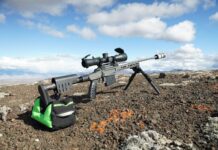Rifle Shooting VS Archery: It’s all in the Trigger
by Evan Williams
The tip of my finger tingled with anticipation. My brother and I had bumped him out of his mid-day bed unknowingly. Now as he started up the basin I knew the break in the ridge he was headed for…386 yards. He paused to look back giving me a split second to settle my crosshairs and harvest the last animal to date with a firearm.
Growing up as a competitive rifle shooter I constantly stressed a smooth trigger squeeze when I shot. The key to a good rifle trigger is using the tip of the index finger. This is where we find the nerve endings and therefore it’s the most sensitive part of the finger as well as allowing us to squeeze the trigger straight back.
Diagram A. shown below displays the correct position of our finger in relation to our rifles trigger and the resulting direction we are squeezing. This results in squeezing the trigger directly into our body. As the shot breaks, our bodies mass, which is positioned directly behind the gun, absorbs the recoil of the shot. This results in a vertical recoil, thus allowing it to recover quicker with a faster target acquisition for the possibility of a second shot.
Diagram A.
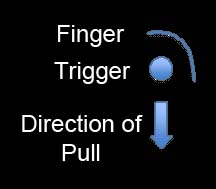
Diagram B. depicts a trigger squeeze where the shooter has over wrapped their finger around the trigger. This shot results in pulling to the right. Our muzzle will jump high and right with the recoil of the shot. This type of finger placement can be seen by most hunters in the heat of the moment. This can also be the result when a shooter’s trigger is too heavy, or by those individuals who are “yanking” the trigger and flinching in anticipation of the firearms recoil.
Diagram B.
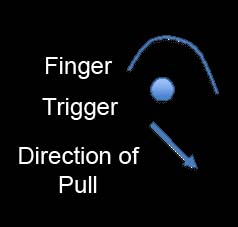
In Diagram C. the shooter is too far out on the tip of their finger and is pushing the shot left. This is most common with shooters that have a higher trigger sensitivity or “hair trigger”. They are afraid of taking the shot too early and the resulting shot goes left. The recoil created from this is high and left.
Diagram C.
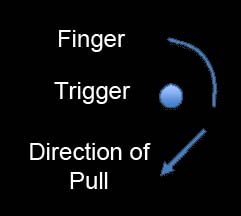
The name of the game in archery hunting dramatically changed with the creation of mechanical trigger aids, or more commonly referred to as releases. Not wholly unlike a rifle trigger many releases use the same gear engagement concept as the internal release mechanism. However, the human mechanics of making a good shot do differ from rifle to archery.
In Diagram D we view an archers release from the side. With this type of finger placement in regards to the trigger, the shooter uses only the tip of their finger on the release. Most often this is a result from shooting a release that is much too long for the archer because they are looking for the same feel they experience with their firearms. Typically this archer will punch the shot as it passes through the area he/she is aiming for commonly referred to as a “drive by”.
Diagram D.

As mentioned above, the mechanics behind a good shot in archery are no different than those desired in a good shot from a firearm. We want to squeeze the trigger in a direct motion towards the shooter. To achieve this we want to actually completely wrap our finger around the trigger creating a hook, shown in Diagram E. As we gradually apply pressure to the trigger by squeezing, we slowly and continually squeeze our drawing arms shoulder blade in towards our spine. In the target archery community this is referred to as “back tension”. Utilizing back tension we achieve a cleaner, smoother release resulting in a more consistent shot and tighter arrow groups.
Diagram E.
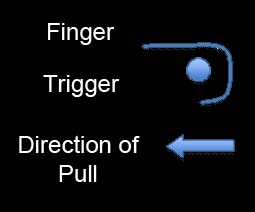
So next time your are shooting your firearms or your archery equipment and you are getting frustrated, relax, take a breath and focus more on your finger placement in regards to the trigger. The results may surprise you.














